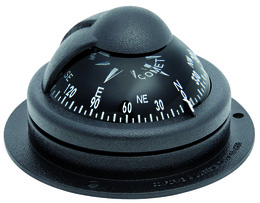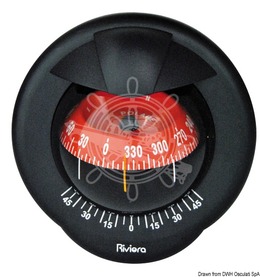| SELECTING A STEERING COMPASS |
 |
 |
Do you want a magnetic or electronic compass?
Magnetic compasses contain a free-spinning compass card, which aligns with the Earth’s magnetic field and points in the direction of magnetic north. Small onboard magnetic fields, caused by ferrous metal (a steel steering wheel or iron engine block), magnets (a speaker or microphone), or current-carrying wires can divert the compass away from magnetic north.
This deviation must be corrected by moving the compass away from the local magnetic interference (if possible) or by adjusting small compensating magnets inside the compass (using a process called swinging the compass). For deviations too large for the compensating magnets, usually greater than 20°, a deviation table may need to be created.
Electronic fluxgate compasses measure the relative strength of magnetic fields passing through two coils of wire. Using sophisticated electronics, these sensors can deduce the direction of the Earth’s magnetic field. They are still affected by local magnetic fields like steel components and speaker magnets, but they can compensate electronically for those fields that do not change in strength or location.
One advantage of electronic compasses is that their sensors may be mounted remotely in many cases. This allows you to place the sensor where it will be least affected by moving magnetic fields and the motion of the boat. Of course, it does increase the complexity of the installation.
What mounting style do you need?
Size and mounting style are the most important criteria when selecting a compass. There are five basic mounting styles:
Flush-mount compasses are set in a cutout in a horizontal surface with half above the surface and half below.
Bracket-mount compasses are highly versatile since the bracket can be mounted on surfaces with different tilt angles. They can also be removed easily for storage or security.
Bulkhead-mount compasses are popular in smaller cruising sailboats (without a binnacle) and on the dashboards of small powerboats, where they are sized and styled to match the other instruments. The aft bulkhead of a sailboat’s cabin provides good visibility in the cockpit, but is sometimes inclined away from vertical. Some compasses can mount at angles of up to 45°, but others require a leveling block to make their internal gimbals work properly
Surface-mount compasses sit on top of a surface and can be easily removed by pressing two buttons. Mounting is easy, as no large holes need to be cut.
Binnacle-mount compasses also mount on a surface or steering pedestal, like those used on wheel-steered sailboats. Powerboat owners select them when there is no room under the mounting surface for a flush-mount compass to protrude.

Riviera Comet 1 flush mount with flat card

Riviera Pegasus bulkhead-mount for sailboats has 45° lubber lines to help estimate tacking angles

Danforth Scout bracket-mount with combination card.
How big should the apparent card diameter be?
We refer to a compass card’s “apparent” size because the dome and fluid inside it magnify the actual card size. Bigger compasses have better performance for several reasons. They are easier to see from a distance or under poor lighting and have larger numerals, markers and lubber lines. With the larger volume of the compass bowl and more mineral oil fluid, they have more effective damping of the motion of the compass card.
How will you read the compass card?
There are two basic types of traditional compasses: direct reading and flat cards.
Direct reading cards: The heading is read from the side of the card nearest the helmsperson. This is more logical for some users, as you don’t have to peer into the compass to see the heading. Direct reading cards do not bisect the compass dome, however, and therefore have more movement in rough conditions.
Flat cards: The heading is read by looking inside the compass dome, on the forward side of the card. These compasses generally have lubberlines (heading references located in the direction the boat is traveling) and additional lines at 45° and 90° to the boat’s heading.
Dual reading cards: Read like both direct and flat cards. These are almost exclusively bulkhead-mounted sailboat compasses, and can be read more easily from the sides than conventional cards.
Digital numeric displays are how electronic compasses display a heading. They often use cardinal and intercardinal (i.e., N, NW, W, SW, S, SE, E, NE) descriptions as well. Some boaters prefer to see their heading displayed spatially on a compass card in the traditional manner, relative to other points on the compass. See our selection of electronic instruments, like the Velocitek ProStart.
What’s inside a compass
The compass dome allows the compass dial to rotate smoothly through heel, pitch and yaw motions. The heavy-duty, optically clear polymer dome also provides clear and accurate magnification of the dial. It is formulated to prevent sun crazing and will stay stable throughout extreme temperature ranges.
Gimbal system: compasses are engineered to operate normally without bottoming out due to pitch and roll. An internal gimbaling system often provides this important function. Gimbals cradle the dial assembly within an axis system bisecting the compass bowl. These ultra-light weight aluminum gimbals and pans are held in place with spring loaded brass pins. A brass counter balance keeps the entire system level.
Compass bowls and housings provide maximum protection and support for the internal compass components. They are made from brass, or high-strength glass reinforced polymers.
Corrector magnets: compasses that are intended for use on boats that could have deviation problems have built-in compensators. These compensators are non-interactive magnets that are balanced and optimally spaced for accurate correction. Compensation instructions are included.
Fluid baffle and roller diaphragm: baffles reduce turbulence in the dampening fluid. Diaphragms allow the fluid to expand or contract with changes in temperature or pressure without forming bubbles.

Compass installation
Selecting a quality compass is only half the job. After all, it is a precision instrument that needs to be installed properly to be effective and accurate. Some basic installation pointers:
- Choose the most visible and comfortable location for the helmsman.
- The compass must be aligned with the fore and aft axis of the boat.
- Route electrical wires away from the compass. Do not mount near instruments containing magnets or near the engine.
- Twist night light wires around one another to cancel out their magnetic field.
- Check for deviation caused by magnetic objects. Deviation is the error caused by iron and steel on a boat (hardware and fittings) that causes the compass to point away from magnetic north. Compasses need to be “swung” to determine the amount of deviation, and corrector magnets, which lie below the compass, can be adjusted by hand to eliminate deviation. However, compass correcting is complicated, and generally requires an expert (a so-called compass adjuster) to do it correctly. Beware: corrector magnets cannot eliminate changing electromagnetic sources, such as electrical wiring and electronics.
COMPASS FLUID TYPE
Most spherical dome compasses built after the 1960s use odorless mineral spirits to damp the movement of the card. If your compass is older, chances are it contains a mix of isopropyl alcohol and water. But no matter what fluid is inside, a bubble is a sign of a developing problem.
Bubbles and low fluid
Today’s compasses are designed to work with a completely fluid-filled dome, therefore a bubble indicates that fluid is missing. Leaks are hard to spot because of the mineral fluid’s tendency to evaporate immediately upon contact with air. Like the tube of a bike tire, a compass can develop a slow leak, in which case you might notice a bubble in the morning when it is still cool, but not in the afternoon, when the compass is heated up and the fluid has expanded. No matter what, a bubble is a sign of trouble and we recommend you have the compass checked out as soon as possible. Get it fixed and have the fluid replenished, otherwise you risk damage to the card.
Продукты
КОМПАС- RIVIERA COMET 1, ЧЁРНЫЙ
25.006.02
КОМПАС- RIVIERA COMET 2, СЕРЫЙ
25.006.03
КОМПАС- RIVIERA, POLARE 3 ", КРАСНЫЙ
RV62.00785.06
КОМПАС- RIVIERA, POLARE 3 ", КРАСНЫЙ
RV62.00785.02
КОМПАС- RITCHIE EXPLORER B-51
M14021050
|